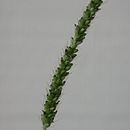Comments
provided by eFloras
Forms with perennating basal buds persisting for more than one season are sometimes separated as a different species, but there are no other distinguishing features and this character is probably of little significance. Specimens lacking basal parts become impossible to assign to species. However, if they are separated,
Setaria pallidefusca is the correct name for the annual form.
The perennial form of Setaria parviflora has been known as S. geniculata P. Beauvois, but that name was based not on Panicum geniculatum Poiret (1798), as has been widely supposed, but on P. geniculatum Willdenow (1809), which applies to a different species.
This species is a forage grass and is used medicinally.
- license
- cc-by-nc-sa-3.0
- copyright
- Missouri Botanical Garden, 4344 Shaw Boulevard, St. Louis, MO, 63110 USA
Description
provided by eFloras
Annual or short-lived perennial with basal buds or a short knotty rhizome. Culms erect or geniculate, 20–90 cm tall. Leaf sheaths keeled, glabrous; leaf blades stiff, flat or involute, 5–30 × 0.2–0.8 cm, glabrous or adaxial surface pilose at base, apex acuminate; ligule ca. 1 mm. Panicle densely cylindrical, 2–15 × 0.5–1.2 cm; branches reduced to a single mature spikelet subtended by 8–12 bristles; axis pubescent; bristles golden or purplish brown when mature, 2–3 times spikelet length. Spikelets elliptic, 1.8–2.5 mm; lower glume ovate, 1/3 as long as spikelet, acute; upper glume broadly ovate, ca. 1/2 as long as spikelet, obtuse; lower floret neuter; lower palea firmly membranous, lanceolate, about as long as the upper floret but narrower, keels wingless, minutely papillose; upper lemma ovate-elliptic, finely rugose. Fl. and fr. Oct–Dec. 2n = 72.
- license
- cc-by-nc-sa-3.0
- copyright
- Missouri Botanical Garden, 4344 Shaw Boulevard, St. Louis, MO, 63110 USA
Habitat & Distribution
provided by eFloras
Mountain slopes, roadsides, waste places. Fujian, Guangdong, Guangxi, Guizhou, Hainan, Hunan, Jiangxi, Sichuan, Taiwan, Yunnan [throughout the tropics and subtropics].
- license
- cc-by-nc-sa-3.0
- copyright
- Missouri Botanical Garden, 4344 Shaw Boulevard, St. Louis, MO, 63110 USA
Synonym
provided by eFloras
Cenchrus parviflorus Poiret in Lamarck, Encycl. 6: 52. 1804; Chaetochloa geniculata (Poiret) Millspaugh & Chase; Panicum geniculatum Poiret; P. pallidefuscum Schumacher; P. rubiginosum Steudel; Setaria glauca (Linnaeus) P. Beauvois var. pallidefusca (Schumacher) T. Koyama; S. gracilis Kunth; S. pallidefusca (Schumacher) Stapf & C. E. Hubbard.
- license
- cc-by-nc-sa-3.0
- copyright
- Missouri Botanical Garden, 4344 Shaw Boulevard, St. Louis, MO, 63110 USA
Physical Description
provided by USDA PLANTS text
Perennials, Terrestrial, not aquatic, Rhizomes present, Rhizome short and compact, stems close, Stems trailing, spreading or prostrate, Stems nodes swollen or brittle, Stems erect or ascending, Stems geniculate, decumbent, or lax, sometimes rooting at nodes, Stems caespitose, tufted, or clustered, Stems terete, round in cross section, or polygonal, Stem internodes solid or spongy, Stem internodes hollow, Stems with inflorescence less than 1 m tall, Stems with inflorescence 1-2 m tall, Stems, culms, or scapes exceeding basal leaves, Leaves mostly cauline, Leaves conspicuously 2-ranked, distichous, Leaves shea thing at base, Leaf sheath mostly open, or loose, Leaf sheath smooth, glabrous, Leaf sheath and blade differentiated, Leaf blades linear, Leaf blades 2-10 mm wide, Leaf blades mostly flat, Leaf blades scabrous, roughened, or wrinkled, Ligule present, Ligule a fringe of hairs, Inflorescence terminal, Inflorescence a dense slender spike-like panicle or raceme, branches contracted, Inflorescence solitary, with 1 spike, fascicle, glomerule, head, or cluster per stem or culm, Inflorescence spike linear or cylindric, several times longer than wide, Flowers bisexual, Spikelets pedicellate, Spikelets dorsally compressed or terete, Spikelet less than 3 mm wide, Spikelets with 1 fertile floret, Spikelets with 2 florets, Spikelet with 1 fertile floret and 1-2 sterile florets, Spikelets solitary at rachis nodes, Spikelets all alike and fertille, Spikelets bisexual, Spikelets disarticulating below the glumes, Spikelets all subtended by bristles, Spikelet bristles 4-many, Spikelet bract s bristles not disarticulating with spikelets, Glumes present, empty bracts, Glumes 2 clearly present, Glumes distinctly unequal, Glumes shorter than adjacent lemma, Glume equal to or longer than spikelet, Glumes 3 nerved, Glumes 4-7 nerved, Lemmas thin, chartaceous, hyaline, cartilaginous, or membranous, Lemma similar in texture to glumes, Lemma becoming indurate, enclosing palea and caryopsis, Lemma 5-7 nerved, Lemma glabrous, Lemma rugose, with cross wrinkles, or roughened, Lemma apex acute or acuminate, Lemma awnless, Lemma margins thin, lying flat, Lemma straight, Palea present, well developed, Palea shorter than lemma, Palea 2 nerved or 2 keeled, Stamens 3, Styles 2-fid, deeply 2-branched, Stigmas 2, Fruit - caryopsis.
Setaria parviflora: Brief Summary
provided by wikipedia EN
Setaria parviflora is a species of grass known by the common names marsh bristlegrass, knotroot bristle-grass, bristly foxtail and yellow bristlegrass. It is native to North America, including Mexico and the United States from California to the East Coast, Central America and the West Indies, and South America.
This grass is a perennial with small, knotty rhizomes. It produces stems 30 centimeters to well over one meter tall. The leaf blades are up to 25 centimeters long and under a centimeter wide. The leaves are whitish-green. The inflorescence is a compact, spikelike panicle up to 8 or 10 centimeters long. Surrounding each spikelet are up to 12 yellow or purple bristles. The bristles stay on the stalk after the seeds drop away.
This grass grows in moist habitat. It can grow in salty habitat such as salt marshes.
- license
- cc-by-sa-3.0
- copyright
- Wikipedia authors and editors

